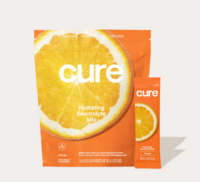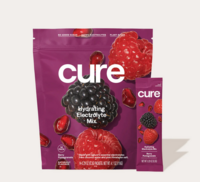Over the past decade, workout classes have become popularized as a way to exercise without needing to think about crafting your own routine at the gym. Their low-maintenance, return on investment model helped create the notorious Barry’s Bootcamp, CorePower Yoga Sculpt, and Solid Core. However, not all workout classes are created equal. While the end result may leave us feeling sweaty and accomplished, research has revealed that our favorite classes can actually be adding extra stress to our bodies.
Depending on the intensity and timing of an exercise, workout classes can create cortisol spikes. Cortisol is the body’s main stress hormone produced and released by our adrenal glands. While cortisol is often discussed when linked to stress, it is not inherently a “bad” hormone. Cortisol levels help regulate blood pressure, suppress inflammation, and help control our sleep cycle. However, certain external factors, like the workout routines we choose, can affect our cortisol levels. It's important to find the right workout classes that leave you feeling energized. Now let's explore how popular workout classes could be affecting your cortisol levels (and what you can do about it).
High-intensity workouts and cortisol: What's the connection?
High-intensity workouts, such as HIIT (High-Intensity Interval Training), CrossFit, and intense cardio classes, can trigger cortisol spikes due to the physical stress they impose on the body. The combination of intense cardiovascular exercise and elevated heart rates can lead to increased cortisol secretion, particularly if participants push themselves beyond their limits. These workouts typically involve short bursts of intense exercise followed by brief periods of rest or lower intensity. While they can be effective for burning calories and improving cardiovascular fitness, they may also elevate cortisol levels, especially if performed frequently or without adequate recovery time. Spacing out HIIT workouts or taking classes in moderation can help prevent added stress on the body or the potential for injuries.
How do I know if I have high cortisol?
The common symptoms attached to too much cortisol include changes in mood, changes in sleep pattern or difficulty sleeping, anxiety, chronic fatigue, muscle fatigue, and a suppressed immune system. These factors often contribute to the counterintuitive effect of HIIT workouts, where people can struggle to lose weight because they may be experiencing an overload in cortisol. While these factors can happen for a myriad of reasons other than HIIT workouts, it’s important to identify if they could be a contributing factor.
Additionally, it’s important not to overstress about your cortisol levels. Cortisol can fluctuate on a daily basis and oftentimes can be hard to manage through one quick fix. If you are worried about your cortisol levels, take a deep breath and reflect on certain daily routines where you can make realistic changes to reduce added anxiety or stress to the body. For example, you can opt to have your morning coffee later in the day after you have eaten food first. While not exercise-related, there are a variety of factors that can compound added stress levels when working out.
The rise of low-intensity workouts
There is a reason why Hot Girl Walks are so popular on TikTok and how communities are built around simply walking. Low-intensity workouts, such as walking, yoga, or Pilates, are less likely to trigger significant cortisol spikes. These activities get your heart rate up without producing an overload of cortisol that may result in adverse outcomes. When combined with weight training or resistance training, these exercises can help you build muscle mass, allowing you to burn more calories without stressing your body with HIIT classes.
Listen to your body, and do what feels right.
I have definitely been in my fair share of workout classes where I felt obligated to stick it out, even though I felt like I was on the verge of passing out. The thoughts in my head go, “well, I paid $32, I should just stay, the person next to me is doing just fine, or there’s only 10 minutes left.”
As the voices in my head act against my body’s intuitive needs, I leave class exhausted but quickly followed are the post-workout endorphins convincing myself it was all fine. The moral of the story is that it is okay to take workout classes at your own pace, even if the instructor is moving forward. After all, you are paying $32 for a class that should work for you.
"When planning your weekly workout routine you want to think of the big picture. What levels of stress is the body enduring, and what energy systems are being used on a daily basis? If you are putting your body through high intensity stress a few days in a row you want to make sure you’re taking enough time to fully recover. If the body isn’t given enough time to recover, you may be doing more harm than good. This may inadvertently cause you to take longer than expected to reach your desired goals," says Dianna Falzarano, a Certified Personal Trainer.
Dianna adds: "My advice is to always start with workouts you enjoy. The type of workouts that will keep you showing up week after week, excited get your body moving. From there, you can add in 2 days of strength training, 1 day of pilates, 1 day of cardio, and whatever else you may enjoy. Just make sure to always build in your days of rest and recovery. Be consistent and show up, that’s the hardest part!"
Kavita Rai is a cancer survivor focused on advancing health equity and solving public health challenges through various avenues: tech-enabled healthcare, policy & law, and patient-led solutions. She currently leads Operations at the early-stage digital health company Ethos Health.













